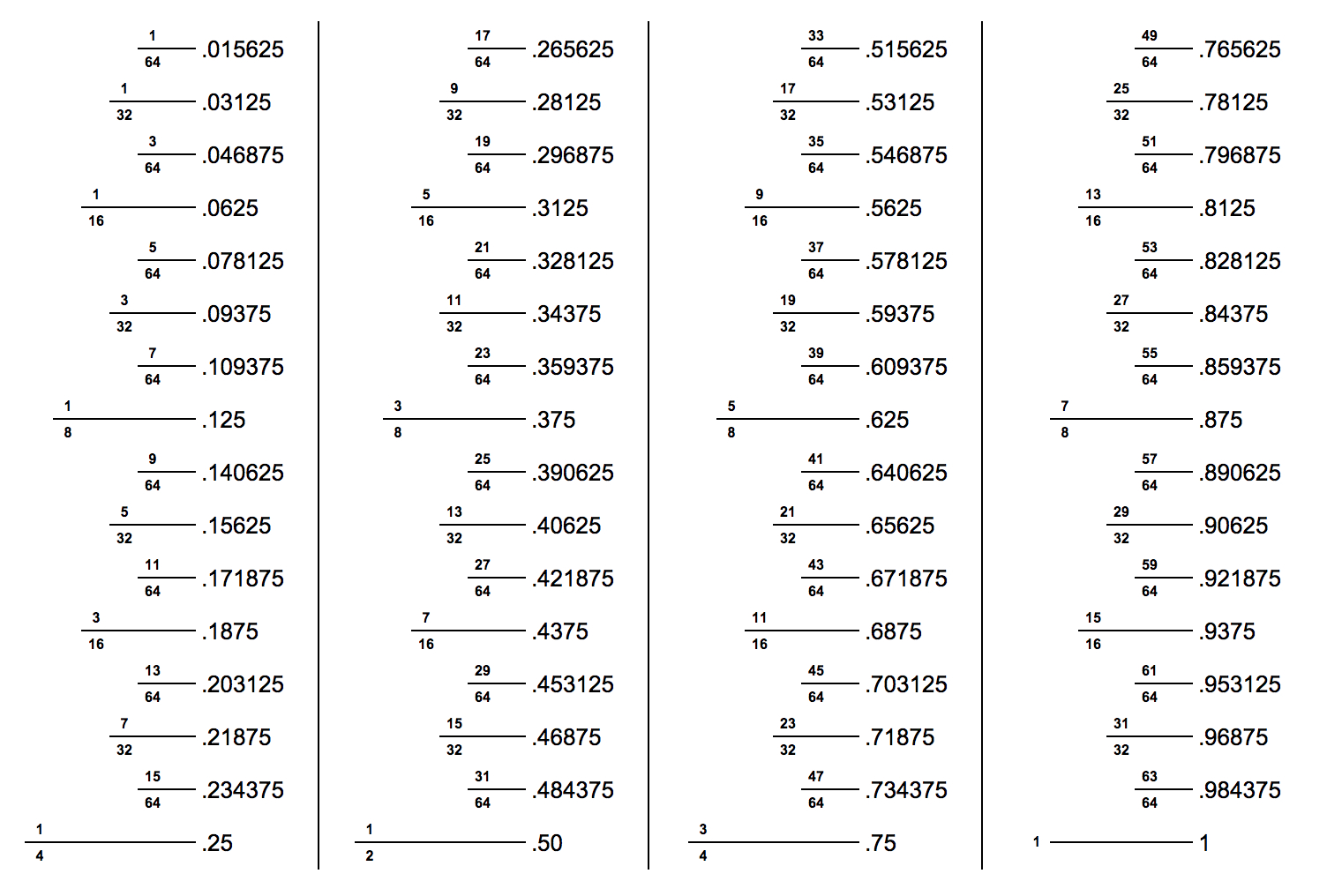
Decimal to fraction converter inches manual#
The tools that the software provides-formulas, cell formatting with rounding, autofill, and sorting by numerical order-obviate any manual calculation and data entry. For some tasks it is faster and less annoying to glance down a column of numbers on a poster than it is to punch calculator buttons or do penciled arithmetic.įor anyone looking to create such a poster or to tailor the design and colors to their own preferences, spreadsheet software makes this fast and easy to do.

Machinists generally truncate the decimals after thousandths for example, a 27/64" drill bit may be referred to in shop-floor speech as a "four-twenty-one drill".)Ĭharts like this, printed at poster size, are widely posted on machine shop walls for handy reference by machinists as they work. 75 are shown to thousandths, which is how machinists usually think about them. So, instead of 78/64 inch, or 1 14/64 inch, the size is noted as 1 7/32 inch.īelow is a chart providing the decimal-fraction equivalents that are most relevant to fractional-inch drill bit sizes (that is, 0 to 1 by 64ths). One aspect of this method of sizing is that the size increment between drill bits becomes larger as bit sizes get smaller: 100% for the step from 1/64 to 1/32, but a much smaller percentage between 1 47/64 and 1 3/4.ĭrill bit sizes are written as irreducible fractions.

For Morse taper-shank drill bits, the standard continues in 1/64 inch increments up to 1¾ inch, then 1/32 inch increments up to 2¼ inch, 1/16 inch increments up to 3 inches, 1/8 inch increments up to 3¼ inches, and a single 1/4 inch increment to 3½ inches. market.ĪNSI B94.11M-1979 sets size standards for jobber-length straight-shank twist drill bits from 1/64 inch through 1 inch in 1/64 inch increments. For example, a set of Forstner bits may contain 10, 15, 20, 25 and 30 mm diameter cutters.įractional-inch drill bit sizes are still in common use in the United States and in any factory (around the globe) that makes inch-sized products for the U.S. Metric dimensioning is routinely used for drill bits of all types, although the details of BS 328 apply only to twist drill bits.
Decimal to fraction converter inches series#
There are also Renard series sequences of preferred metric drill bits: This subsetting of standard sizes is in contrast to general practice with number gauge drill bits, where it is rare to find a set on the market which does not contain every gauge. Drill bits of the less routinely used sizes, such as 2.55 mm, would have to be ordered from a specialist drill bit supplier. Sets are not commonly available in smaller size increments, except for drill bits below 1 mm diameter. In 0.1 mm increments, any engineers' store. In 0.5 mm increments, any hardware store. Sets of bits in 1 mm increments might be found on a market stall. Bits at size increments of 1 mm are most commonly available, and lowest price. The price and availability of particular size bits does not change uniformly across the size range. This reflects both the smaller drilled hole diameter tolerance possible on smaller holes and the wishes of designers to have drill bit sizes available within at most 10% of an arbitrary hole size. In smaller sizes, bits are available in smaller diameter increments. For example, British Standard BS 328 defines 230 sizes from 0.2 mm to 25.0 mm.įrom 0.2 through 0.98 mm, sizes are defined as follows, where N is an integer from 2 through 9:įrom 1.0 through 2.95 mm, sizes are defined as follows, where N is an integer from 10 through 29:įrom 3.0 through 13.9 mm, sizes are defined as follows, where N is an integer from 30 through 139:įrom 14.0 through 25.0 mm, sizes are defined as follows, where M is an integer from 14 through 25: Standards organizations define sets of sizes that are conventionally manufactured and stocked. Metric drill bit sizes define the diameter of the bit in terms of standard metric lengths. The case that holds them in an indexed order (by size), via a graduated series of holes, is called a drill index. Metric drill set, 1.0–6.0 mm by 0.1 mm, jobber length.


 0 kommentar(er)
0 kommentar(er)
